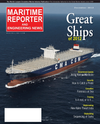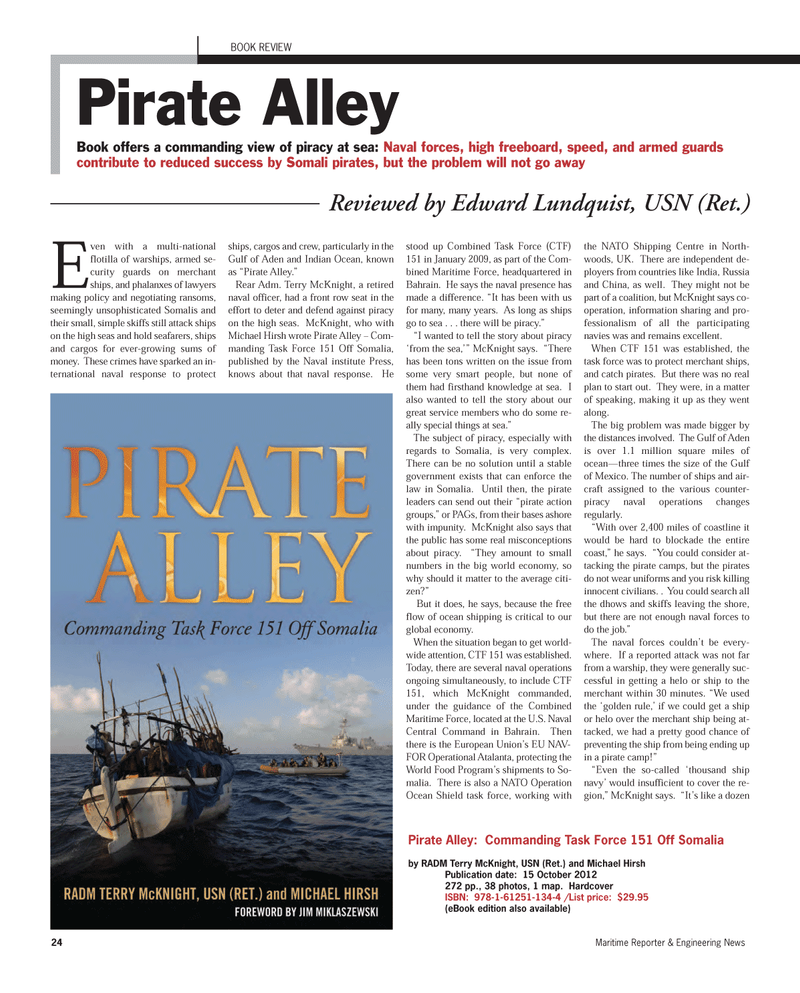
Page 24: of Maritime Reporter Magazine (December 2012)
Great Ships of 2012
Read this page in Pdf, Flash or Html5 edition of December 2012 Maritime Reporter Magazine
24Maritime Reporter & Engineering News Even with a multi-national flotilla of warships, armed se- curity guards on merchantships, and phalanxes of lawyers making policy and negotiating ransoms, seemingly unsophisticated Somalis andtheir small, simple skiffs still attack ships on the high seas and hold seafarers, ships and cargos for ever-growing sums of money. These crimes have sparked an in- ternational naval response to protect ships, cargos and crew, particularly in the Gulf of Aden and Indian Ocean, known as ?Pirate Alley.? Rear Adm. Terry McKnight, a retired naval officer, had a front row seat in the effort to deter and defend against piracy on the high seas. McKnight, who withMichael Hirsh wrote Pirate Alley ? Com- manding Task Force 151 Off Somalia, published by the Naval institute Press, knows about that naval response. He stood up Combined Task Force (CTF) 151 in January 2009, as part of the Com-bined Maritime Force, headquartered in Bahrain. He says the naval presence has made a difference. ?It has been with us for many, many years. As long as ships go to sea . . . there will be piracy.? ?I wanted to tell the story about piracy ?from the sea,?? McKnight says. ?There has been tons written on the issue fromsome very smart people, but none of them had firsthand knowledge at sea. I also wanted to tell the story about our great service members who do some re-ally special things at sea.? The subject of piracy, especially with regards to Somalia, is very complex. There can be no solution until a stablegovernment exists that can enforce the law in Somalia. Until then, the pirate leaders can send out their ?pirate actiongroups,? or PAGs, from their bases ashore with impunity. McKnight also says that the public has some real misconceptionsabout piracy. ?They amount to small numbers in the big world economy, so why should it matter to the average citi- zen??But it does, he says, because the freeflow of ocean shipping is critical to our global economy. When the situation began to get world- wide attention, CTF 151 was established. Today, there are several naval operations ongoing simultaneously, to include CTF 151, which McKnight commanded,under the guidance of the CombinedMaritime Force, located at the U.S. Naval Central Command in Bahrain. Then there is the European Union?s EU NAV- FOR Operational Atalanta, protecting the World Food Program?s shipments to So- malia. There is also a NATO Operation Ocean Shield task force, working with the NATO Shipping Centre in North- woods, UK. There are independent de- ployers from countries like India, Russia and China, as well. They might not be part of a coalition, but McKnight says co- operation, information sharing and pro-fessionalism of all the participatingnavies was and remains excellent. When CTF 151 was established, the task force was to protect merchant ships, and catch pirates. But there was no real plan to start out. They were, in a matter of speaking, making it up as they went along.The big problem was made bigger by the distances involved. The Gulf of Aden is over 1.1 million square miles of ocean?three times the size of the Gulfof Mexico. The number of ships and air- craft assigned to the various counter- piracy naval operations changes regularly. ?With over 2,400 miles of coastline it would be hard to blockade the entire coast,? he says. ?You could consider at- tacking the pirate camps, but the pirates do not wear uniforms and you risk killinginnocent civilians. . You could search all the dhows and skiffs leaving the shore, but there are not enough naval forces to do the job.? The naval forces couldn?t be every- where. If a reported attack was not far from a warship, they were generally suc- cessful in getting a helo or ship to themerchant within 30 minutes. ?We used the ?golden rule,? if we could get a ship or helo over the merchant ship being at- tacked, we had a pretty good chance of preventing the ship from being ending up in a pirate camp!??Even the so-called ?thousand ship navy? would insufficient to cover the re- gion,? McKnight says. ?It?s like a dozen BOOK REVIEWPirate AlleyBook offers a commanding view of piracy at sea: Naval forces, high freeboard, speed, and armed guards contribute to reduced success by Somali pirates, but the problem will not go away Reviewed by Edward Lundquist, USN (Ret.) Pirate Alley: Commanding Task Force 151 Off Somalia by RADM Terry McKnight, USN (Ret.) and Michael Hirsh Publication date: 15 October 2012272 pp., 38 photos, 1 map. Hardcover ISBN: 978-1-61251-134-4 /List price: $29.95 (eBook edition also available)MR#12 (18-25):MR Template 12/5/2012 12:39 PM Page 24

 23
23

 25
25
